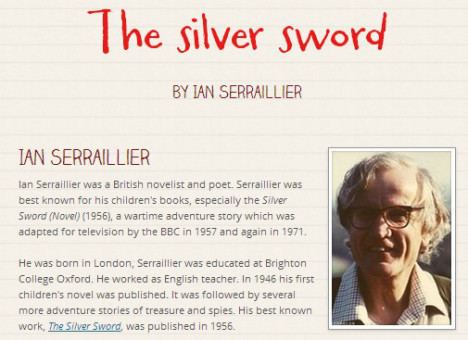Name Ian Serraillier Role Novelist | Died November 28, 1994 | |
 | ||
Books The Silver Sword, There's No Escape, Road to Canterbury, Clashing Rocks, Suppose you met a witch | ||
Ian Serraillier Life & Works
Ian Serraillier (24 September 1912 – 28 November 1994) was an English novelist and poet. He retold legends from England, Greece and Rome and was best known for his children's books, especially The Silver Sword (1956), a wartime adventure story that the BBC adapted for television in 1957 and again in 1971.
Contents
- Ian Serraillier Life Works
- Brenda reading the visitor written by ian serraillier
- Early life and education
- Writing and editing
- Personal life
- Papers of Ian Serraillier
- References

Brenda reading the visitor written by ian serraillier
Early life and education

Serraillier was born in London on 24 September 1912. He was the eldest of the four children of Lucien Serraillier (1886–1919) and Mary Kirkland Rodger (1883–1940). His father died as a result of the 1918 flu pandemic.
Serraillier was educated at Brighton College and at St Edmund Hall, Oxford, and he taught English at Wycliffe College in Gloucestershire from 1936 to 1939, at Dudley Grammar School in Worcestershire from 1939 to 1946, and at Midhurst Grammar School in West Sussex from 1946 to 1961. As a Quaker he was granted conscientious objector status in World War II. Serraillier was a member of the Peace Pledge Union.
Writing and editing

In 1946, he published his first two children's books: They Raced for Treasure, a story of sailing, treasure and spies, and Thomas and the Sparrow. These were followed by several more adventure stories, including his best known work, The Silver Sword (1956). This brings to life the story of four refugee children, three of them siblings: Ruth, Edek, and Bronia. The fourth, Jan, is another of the many Warsaw war orphans who has somehow met their father and then fainted near the bombed-out basement that serves as the siblings' home. The four join together in their search for the siblings' parents in the chaos of Europe, immediately after the Second World War. In the United States the book was published under the title Escape from Warsaw.
Beginning in 1961, Serraillier devoted most of his time to writing fiction and non-fiction, poems, and educational programmes for television. He also produced his own retellings of classic and ancient legends for children, in prose and verse, including Beowulf, works by Chaucer, English folklore, and Greek and Roman myths. In 1948, together with his wife, Anne Margaret Rogers, he founded the New Windmill Series, published by Heinemann Educational Books, which set out to provide inexpensive editions of good stories, including fiction, travel and biography for older readers. He continued as co-editor of the series until the onset of Alzheimer's disease in the early 1990s.
The Ivory Horn (1960), a retelling of the Roland legend, was a runner-up for the Carnegie Medal, as had beenThe Silver Sword. As a popular children's author, Serraillier was invited to Children's Literature Summer Camps for members of the Puffin Book Club, run by Colony Holidays (predecessor to ATE Superweeks) along with other popular children's authors such as Joan Aiken and Clive King.
Personal life
Serraillier lived and worked in an old flint cottage near Chichester, in West Sussex. He and his wife, Anne Margaret Rogers, had three daughters and a son.
Ian Serraillier died on 28 November 1994.
Papers of Ian Serraillier
The "Papers of Ian Serraillier", held at the University of Reading, largely comprise manuscripts, typescripts, and galley proofs, including Fight for Freedom, The Clashing Rocks, The Cave of Death, Havelock the Dane, They Raced for Treasure, Flight to Adventure, and The Silver Sword. They also contain correspondence with publishers; other business and literary correspondence; notebooks with poems, ideas, and story outlines; rejection letters; publishers' agreements; press cuttings; research material; lecture notes and typescripts; obituaries, and other miscellaneous papers.
